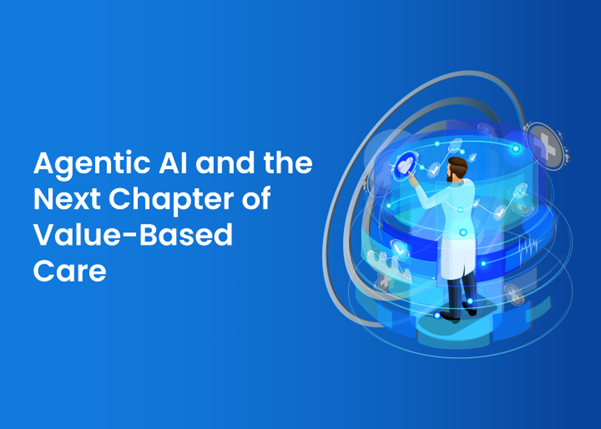
@ShahidNShah


There was a moment, late on a Friday afternoon, when the care-manager at a midsize health-system realised that the next day’s discharges were already stacking up, the readmission risk was climbing, and her team was still buried under paperwork. The sense of urgency was operational as much as it was strategic.
Imagine a world where
For many value-based care (VBC) organisations that world is arriving now—and for home-care providers the margin between success and failure is narrowing fast.
In this article we examine how agentic AI can advance the value-based care model. We’ll draw on market insights and use cases like patient caregiver matching to make the case for home-care organizations.
At one large integrated health-system, leadership realised that shifting to value-based care wasn’t simply about signing up for an Accountable Care Organization (ACO) arrangement or adopting bundled payments.
They had done that.
But they found themselves still managing massive volumes of data, still chasing readmissions, still watching margins erode under the old fee-for-service cost model.
Traditional value-based care promised three things: better outcomes, lower costs, and improved patient experience. But the execution faltered because:
Consider the story of a home-care agency serving a population of high-risk seniors. The agency’s team noticed that frequent hospitalisations tended to happen on weekends, when staffing was lower and patients missed their regular monitoring check-ins.
The agency had a value-based agreement: they were responsible for 30-day outcomes post-discharge but lacked a real-time way to monitor social risk factors, connect with community resources, or intervene early.
Result: repeated readmissions, penalties, and frustration.
This scenario echoes many of the pain-points documented in recent research.
For home-care heads, the priority is always about achieving value-based goals demands more than new contracts. You need to rethink the care-workflow, data-flows, and the supporting systems. An agentic approach to AI where systems don’t just suggest but act and coordinate, may offer the leap forward.
When people think about AI in healthcare, they often imagine analytics dashboards or predictive models that throw alerts. But agentic AI works differently. It doesn’t stop at analysis. It interprets, decides, and acts. Think of it like a seasoned care coordinator who anticipates what’s next instead of waiting for instructions.
Picture a regional home-health network managing hundreds of seniors with heart conditions. Traditionally, alerts about deteriorating vitals would reach nurses at the end of the day. By then, a few patients had already been admitted to the ER. With an agentic AI layer, those same alerts now trigger immediate triage calls, reschedule nursing visits, and notify families in minutes.
What changed was the AI’s ability to understand intent and act across systems without constant human hand-holding.
In technical terms, agentic AI uses multiple autonomous agents that collaborate in real time. Each agent performs a role. One might analyze risk, another coordinates scheduling, another updates records. Together, they close the feedback loop that traditional AI never could. (Healthcare IT Today, 2024)
Recent pilot programs in remote care and chronic disease management have shown measurable improvements.
A survey found that AI-enabled care coordination reduced preventable hospitalizations by up to 18 percent among Medicare patients enrolled in value-based contracts. (Health Affairs Blog, 2024)
Another study reported that AI-driven decision support cut average discharge-to-follow-up time by nearly 40 percent (Journal of Medical Internet Research (JMIR), 2024). These outcomes aren’t abstract. They mean fewer avoidable admissions and better patient retention under shared-savings models.
The difference lies in timing. Agentic AI acts before an adverse event, not after. It brings together clinical data, home-care notes, pharmacy updates, and even social indicators like food insecurity or transportation barriers. The outcome is a system that moves from reactive to responsive, from data collection to decision execution (National Library of Medicine., 2023).
For health-system executives, this marks a new operational logic. Instead of relying on human escalation chains or dashboard fatigue, agentic AI enables a network of always-on digital colleagues.
Each one knows the goal: healthier patients, reduced costs, and care teams free to focus on empathy and human judgment (McKinsey & Company., 2023).
Agentic AI directly supports the goals of value-based care by acting on insights faster and more precisely than human teams can alone. Below are the core alignment points.
Example: A post-acute network using agentic AI reduced cardiac readmissions within three months by automating follow-ups

Continuous monitoring across EHR, RPM devices, and home-care notes lets health monitoring agents spot early risk signals and trigger same-day outreach or visit changes.
Coordination Agents track vitals, med adherence, and symptom logs, then auto-coordinate nurse calls and caregiver messages when patterns point to decompensation risk.
An “orchestration” agent confirms transport, books follow-ups, and closes documentation tasks in minutes instead of days.
Patient-caregiver scheduling agents forecast bed demand, surface bottlenecks, and auto-notify teams to move patients or adjust schedules.
A risk agent updates scores hourly and kicks off playbooks: remote vitals checks, pharmacist calls, or home-visit rescheduling.
A documentation agent logs every intervention, generates visit summaries, and syncs payer-required fields to protect shared-savings revenue.
Scheduling agents watch for transportation gaps, missed refills, or food insecurity flags, then arrange rides or pharmacy deliveries and notify the care team.
Key Considerations and Challenges for Adoption
Value-based care rises or falls on execution. The right contracts mean little if data is scattered, staff feel stretched, or automation acts without guardrails. Think of adoption as a series of small, safe wins that add up fast: clean data paths, clear playbooks, and proof that each agent action links to a better outcome and a cleaner claim.
The checklist below keeps leaders focused on what matters most right now.
| Challenge | Why it matters | What to decide now | Quick win | Metrics |
| Fragmented data | Slows action and blurs risk | One patient ID, one record of truth | Map feeds, fix top 5 data gaps | Match rate, data latency |
| Workflow overload | Staff lose time on clicks and calls | Which tasks will agents own | Auto-book post-discharge visits | Minutes saved per task |
| Clinical safety | Wrong action at the wrong time hurts care | Approval rules and fail-safes | Start with read-only suggestions, then enable actions | Alert acceptance rate, near-miss count |
| SDoH blind spots | Social barriers drive readmissions | Triggers for transport, refills, food support | Add ride and pharmacy workflows | Gap closures, 30-day follow-up kept |
| Documentation quality | Missing notes cut revenue | Required fields and templates | Auto-generate visit summaries | Note completeness, denial rate |
| Change fatigue | New tools stall if flow feels heavier | Train on workflows, not features | “Two-click” shortcuts for nurses | User NPS, task completion rate |
| Bias and drift | Uneven results across cohorts | Fairness checks and retraining rhythm | Monthly review of model outputs | Equity score, drift alerts |
| Reliability at scale | Backlogs break trust | Clear SLAs and fallback behavior | Queue and retry policies | SLA hit rate, backlog size |
| Vendor sprawl | Too many tools raise cost | Consolidate actions in one pane | Retire overlaps after pilot | Active-user ratio, tech cost per member |
| Proof of value | Leaders need clear results fast | Pick a few outcomes and own them | 90-day pilot with weekly readouts | Readmissions, LOS, avoidable ED rate |
Goal: link every agent action to a clinical, operational, or financial outcome. Keep it small, visible, and repeatable.
Value-based care is built on a simple promise: better outcomes at lower cost. Yet, the path to that promise has been anything but simple. Agentic AI offers a way forward by transforming static data into real-time action. It closes loops that once depended on phone calls, paperwork, and fragmented systems.
For leaders, the challenge is how to make it work within the culture and rhythm of care delivery. When thoughtfully deployed, agentic AI becomes invisible support, guiding every decision toward measurable results. Readmissions fall, staff workloads shrink, and patients experience care that feels personal again.

If you’re considering ways to enhance your smile, the Bioclear Method offers a cutting-edge approach that prioritizes the preservation of your natural teeth. Unlike traditional procedures that may …
Posted Oct 27, 2025 Dental Care Dentistry
Connecting innovation decision makers to authoritative information, institutions, people and insights.
Medigy accurately delivers healthcare and technology information, news and insight from around the world.
Medigy surfaces the world's best crowdsourced health tech offerings with social interactions and peer reviews.
© 2025 Netspective Foundation, Inc. All Rights Reserved.
Built on Dec 12, 2025 at 1:25pm